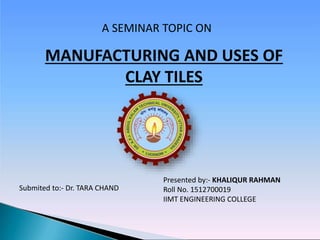
Manufacturing and uses of clay tiles.
- 1. A SEMINAR TOPIC ON Submited to:- Dr. TARA CHAND MANUFACTURING AND USES OF CLAY TILES Presented by:- KHALIQUR RAHMAN Roll No. 1512700019 IIMT ENGINEERING COLLEGE
- 2. CONTENTS •Introduction •History •Manufacturing process •Types of tiles •Uses of tiles
- 3. A tile is a manufactured piece of hard-wearing material such as ceramic, stone, or even glass. Tiles are generally used for covering roofs, floors, walls, showers, or other objects such as tabletops. Introduction
- 4. Historically, man has desired to create living spaces which were beautiful, durable, and user friendly. with that in mind, ceramic tile has been made by man for 4000 years. Beautiful tiled surfaces have been found in the oldest pyramids, the ruins of Babylon, and ancient ruins of Greek cities. Decorative tile work was invented in the near east, where it has enjoyed a longer popularity and assumed a greater variety of design than anywhere in the world. During the Islamic period, all methods of tile decoration were brought to perfection in Persia. Introduction
- 5. In Europe decorated tiles did not come into general use outside Moorish Spain until the second half of the 12th century. The tile mosaics of Spain and Portugal, the maiolica floor tiles of renaissance Italy, the faiences of Antwerp, the development of tile iconography in England and in the Netherlands, and the ceramic tiles of Germany are all prominent landmarks in the history of ceramic tile.
- 6. Manufacture:
- 7. The raw materials used to create tiles are all found in the ground. These raw materials, like clay is quarried and refined. They are then mixed. A dry mixture of clay, Magnesium silicate and other ingredients are pressed into a mould, and then fired at an extremely high temperature. The ingredients used in this process are slightly wet. They are forced through a nozzle, which forms the tile’s shape. Other methods of creating tiles are slush mould and beehive kilns.
- 8. There are many types of tiles used for residential and commercial applications. 1. Roof tiles 2. Floor tiles 3. Pebble tiles 4. Ceiling tiles 5. Wall tiles
- 9. Introduction
- 10. Roof tiles are designed mainly to keep out rain, and are traditionally made from locally available materials such as clay or slate. Flat tiles - the simplest type, which are laid in regular overlapping Roofing tiles
- 11. Introduction
- 12. These are commonly made of ceramic or stone. Recent technological advances have resulted in rubber or glass tiles for floors as well.
- 13. Pebble Tiles is a composite material made up of marble pebbles or pieces of natural stone in different sizes, bound together with a transparent white or colored resin.
- 14. Ceiling tiles are type of tiles used for covering ceilings of rooms. Suspended ceilings Acoustic Ceilings Decorative Ceiling Tile
- 15. The concept behind using wall tiles is decorating the interior of a home without adding much stuff to the home.
- 17. Here are some places around the home that can benefit from tile applications. COUNTER BATHROOM BACKSPLASH FLOORING WALL ACCENTS EXTERIOR Uses:
- 18. COUNTER Ceramic tile is among the most common materials for kitchen countertops. Because it's hard and water-resistant, it holds up extremely well to the moist and often humid environment of the kitchen.
- 19. BATHROOM: Mostly used on floor They are also commonly used in walls.
- 20. BACKSPLASH : Almost all backsplashes are made of tile because of its natural water resistance. Some people prefer stone or marble, but these are expensive materials.
- 21. FLOORING : Tile is one of the cheapest flooring options, especially compared to popular materials such as hardwood and marble. Most tiles can withstand heavy use in living rooms and the heat and moisture of bathrooms.
- 22. WALL ACCENTS: Small decorative tiles make great accents for walls, counters, and flooring. They usually come in stronger, deeper colours and feature interesting patterns, often to complement the colour of bigger tiles.
- 23. EXTERIOR: Some tiles can actually be used on the exterior walls of your home. These are usually decorative ones made to look like natural materials, such as wood and stone. They make great alternatives to exterior painting, since they don't fade and can withstand most outdoor elements.
- 24. Thanks….
